Layout of the Port of Tianjin
The Port of Tianjin is divided into nine areas: the three core ("Tianjin Xingang") areas of Beijiang, Nanjiang, and Dongjiang around the Xingang fairway;[1] the Haihe area along the river; the Beitang port area around the Beitangkou estuary; the Dagukou port area in the estuary of the Haihe River; and three areas under construction (Hanggu, Gaoshaling, Nangang).
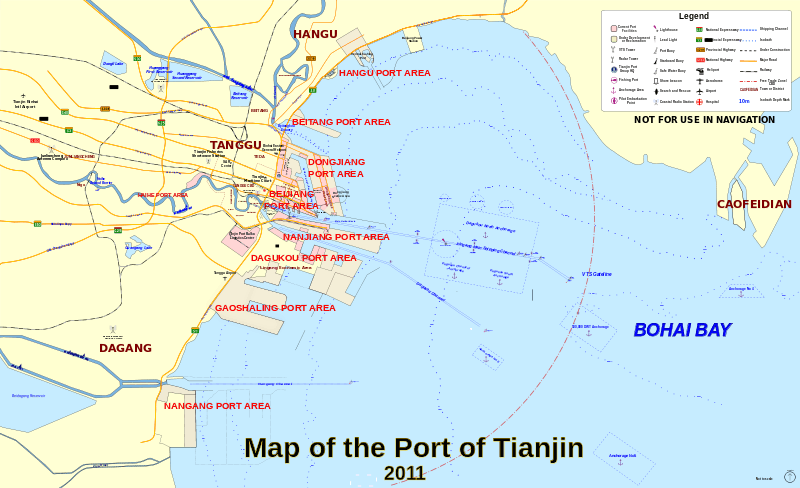
Beijiang Port Area
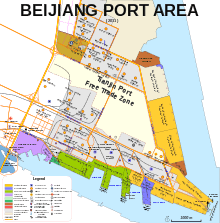
Beijiang Port Area (Chinese: 北疆港区; pinyin: běijiāng gǎngqū; lit.: 'Northern Border Port Area') includes the original areas of the Tanggu New Port, plus new facilities built on reclaimed land north of the Main Basin. It covers approximately 36.8 km2, has 18.9 km of coastline, and contains mostly container and general cargo terminals. It is also the main service and administration area of the port, including the Tianjin Port Container Logistics Center, the Tianjin Port Trade and Shipping Service Area, and the 7 km2 Tianjin Port Free Trade Zone
| Terminal | Structure | Type | Berths | Berth Number | Quay length | Depth | Quay Cranes | Area | Annual Capacity | Owner | Notes |
|---|---|---|---|---|---|---|---|---|---|---|---|
| Tianjin Passenger Terminal (天津港客运站) | ? | Passenger | 3 (10,000 DWT) | K1-3 | 439 m | 8–12 m | 1 (10 t) | 1.03 ha | 350,000 pass. | TPC | |
| First Stevedoring Company Terminal[2] (天津港第一港埠有限公司杂货码头) | Concrete High Pile Platform (混凝土高桩承台) | Multi-Purpose | 6 (3×10,000; 1×15,000; 2×30,000 DWT; ) | G1-3; G5-G6bis | 1,401 m | 11-10.5 m | 6×40 t; 2×35 t; 3×25 t; 1×10 t | ? | 1 Mt; 560,000 TEU | TPC | |
| Tianjin Xingang Sinor Terminal (天津新港赛挪码头) | ? | General & Specialist | 1 (38,000 DWT) | G4 | 200 m | 10.7 m | 1×10 t | ? | 0.6 Mt | TPC, GB Terminals | Square-shaped cargo. |
| First Basin Barge Wharf (一港池西侧驳船码头) [3] | ? | Barge | n/a | ? | 74 m | 4.8 m | n/a | n/a | n/a | Remains of former First Stevedoring Barge Wharf. | |
| Second Stevedoring Company Terminal (天津港埠二公司杂货码头)[4] | Concrete High Pile Platform | Multi-purpose | 9 (4×70,000; 3×15,000; 2×25,000 DWT)[5] | G7-G15 | 1,951 m | 15-8.5 m | 3×40 t; 1×61 t; 14×25 t; 11×10 t | 43 ha | 20 Mt; 250,000 TEU | TPD | 2 Container berths; Bulk grain terminal |
| First Pier Head Wharf (天津港第二港埠有限公司一突堤堤头码头)[6] | ? | General | 1×10,000 DWT | Yitudi | 217.25 m | 9 m | n/a | ? | n/a | Tug wharf | |
| Fourth Stevedoring Company Terminal[7] (天津港埠四公司码头) | Concrete High-Pile Platform | Bulk & General | 5 (3×30,000 DWT; 2×50,000 DWT)[8] | G16-20 | 912 m | 9–13.5 m | 5×25 t; 11×10 t | 46 ha | capacity | TPC | Timber, Mineral Ore |
| Second Pier Head Wharf (二突堤端部横码头) | ? | General | 1 | Ertudi | 140 m | 5.5 m | 0 | n/a | ? | ||
| Chimbusco Beijiang Bunkerage Base (天津中燃船舶燃料公司北疆燃油供应基地) | Oil | 2×10,000 DWT; 5×5,000 DWT | Gongyou | 186 / 612 m | 11 m | ? | n/a | 1.2 Mt | In a basin at the southern tip of Pier No. 2. | ||
| Fifth Stevedoring Company Terminal[9] (天津港埠五公司码头) | Concrete High Pile Platform | Bulk & General | 5 (3×70,000; 2×150,000 DWT) | G22-G26 | 996 m | 15–16.5 m | 19 (76×40 t; 12×10 t) | 35 ha | 2.3 Mt | TPC | |
| Third Pier Head Wharf (三突堤端部横码头) [10] | ? | General | 2 | Santudi | 246 m | 8.2 m | 5 | n/a | ? | ||
| Tianjin Port Container Terminal (天津港集装箱码头)[11] | Concrete High Pile Platform | Container | 4 (1×25,000DWT; 3×50,000 DWT) | G21; G27-G29 | 398+825 m | 12–16 m | 14 (3×30.5 t; 1×40.5 t; 10×61 t) | 70 ha | 1.6 M TEU | TPD | comments |
| Tianjin Orient Container Terminal (天津东方海陆集装箱码头)[12] | High Pile Beam & Slab (高桩梁板承台) | Container | 4 (100,000 DWT) | G30-G33 | 1,138 m | 14 m | 10 (2×30.5 t; 3×40.5 t; 5×43 t | 45 ha | 1.4 M TEU | TPC, DP World, NWA | |
| Tianjin Dongtudi East Service Craft Wharf (天津港东突堤东侧工作船码头)[13] | High Pile Trestle Double-sided Pier (高桩栈桥式两侧靠船) | Service | n/a | ? | 368+148 m | 5.5 m | 0 | n/a | n/a | T-shaped bridge pier for Tug & Lighter Co. | |
| Tianjin Five Continents International Container Terminal (天津五洲国际集装箱码头)[14] | Caisson Gravity Wall (沉箱重力) | Container | 4 (100,000 DWT) | G35-G38 | 1,202 m | 13.8–15.7 m | 12 (65 t) | 35 ha | 1.5 M TEU | TPC, CMHI, China Shipping, NWS, CP | comments |
| Tianjin Port RO-RO Terminal (天津港滚装码头)[15] | ? | Ro-Ro | 2 (50,000 – 80,000 DWT) | N1-2 | 471 m | 14.1 m | 0 | 13,8 ha | 200,000 CEU; 1.5 Mt edible oil | TPC, NYKK, WWL | Also grain and edible oil. |
| Tianjin Port Alliance International Container Terminal (天津港联盟国际集装箱码头)[16] | ? | Container | 4 (100,000 DWT) | N3-6 | 1,100 m | 15.5 m | 11 (65 t) | 63.2 ha | 1.85 M TEU | TPD, PSA International, OOCL, APMT | |
| Tianjin Port Euroasia International Container Terminal[17] (天津港欧亚国际集装箱码头) | ? | Container | 3 (2×100,000; 1×70,000 DWT) | N7-9 | 1,100 m | 16 m | 10 (65 t) | 83,6 ha | 1,8 M TEU | TPD, COSCO Pacific, APMT | |
| Tianjin Port Shenghua International Container Terminal[18] (天津港盛华国际集装箱码头) | ? | Container | 3 (100,000 DWT) | N10-12 | 1,100 m | 15.5–18 m | n/a | n/a | 1.7 M TEU | TPC, Tianjin Terminal Link, CASC | Under Construction |
| Beigangchi Gangwei Storage Wharf (北港池港威仓储码头)[19] | ? | Sand | ? | n/a | 115m | ? | n/a | n/a | ? | Gangwei Storage Co. | Temporary |
| TPG Global RO-RO Terminal (天津港环球滚装码头)[20] | ? | Ro-Ro | 2 (75,000 DWT) | N13-14 | 580 m | 11.4 m | 0 | 34 ha | 500,000 CEU | TPC, NYKK, WWL | Tilted wharf (75%) to account for tides. |
| Beigangchi Longboda Wharf (北港池隆博达码头)[19] | ? | Sand | ? | n/a | 150m | ? | n/a | n/a | ? | Tianjin Longboda Materials | Temporary |
Nanjiang Port Area
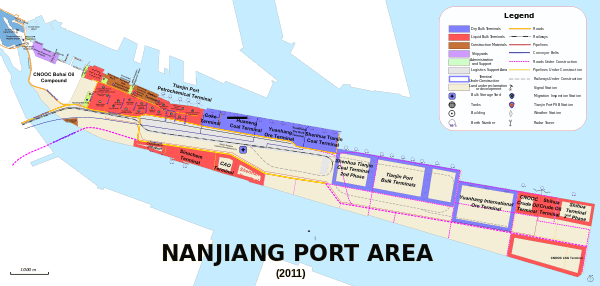
The Nanjiang Area(Chinese: 南疆港区; pinyin: nánjiāng gǎngqū; lit.: 'Southern Border Port Area') lies on an artificial island 16 km long (east to west) by 1.3–2 km wide (north to south), with an area of approximately 26 km2. Shoreline is 14.2 km long on the north side(opening to the Main Channel), and 12 km on the south side (opening to the Dagusha Channel). This port area contains the bulk cargo terminals, in particular the large oil, ore and coal terminals.
| Terminal | Structure | Type | Berths | Berth Number | Quay length | Depth | Quay Cranes | Area | Annual Capacity | Owner | Notes |
|---|---|---|---|---|---|---|---|---|---|---|---|
| Tourist Boats Wharf (旅游船码头)[21] | Wooden Pontoon | Service | n/a | ? | 190 m | 2 m | n/a | ? | ? | ? | Former Yuanyang service wharf. |
| Beihai Search and Rescue’s Tianjin Base Wharf (北海救助局天津基地码头)[22] | Patrol | 2 | ? | 115+65 m | 6-5.5 m | ? | 0.7 ha | n/a | CSR | One of three dynamic rescue stations | |
| Bohai Oil’s Materials Supply Company Comprehensive Service Terminal (渤海石油物资供应公司综合作业码头) | Service/Oil | ? | Bohaiyou 4–6 | 180+422+875 m | 5–6 m | 6 | n/a | ? | CNOOC Bohai Oil Co. | OSV base. | |
| AtoN Base (天津海事局航标区基地) | 板桩拉锚结构 | Patrol | n/a | Haibiao | 245 m | 6–4 m | n/a | ? | ? | Tianjin MSA | Angular Pier |
| Tianjin Beifang Ganghang Petroleum Terminal (天津北方港航石化码头)[23] | Oil | 2×50,000 DWT | Beifangyou 1–2 | 300 m | ? | 6 loading arms | 13.98 ha | 1.9 Mt | TJNP | ||
| First Harbor Engineering First Wharf ( 一航局1号码头) [24] | 栈桥式高桩梁板 | Service | Yihang Yihao | 200 m | 7 m | 2×3,000 DWT; 1 barge slip | 12 ha | ? | FHE | ||
| First Harbor Engineering Pre-stressed Concrete Structures Factory Wharf ( 中港一航局一公司南疆新建预应力预制构件厂出运码头)[25] | 高桩梁板 | Service | 4×3,000 DWT | Yihang Erhao | 250+180 m | 6 m | 4×3,000 DWT | 71.1 ha | FHE | ||
| MSA Shipping Management Wharf (海事局航政码头) | Patrol | n/a | Hangzheng | 275 m | 4 m | n/a | ? | n/a | Tianjin MSA | ||
| Nanjiang Harbor Terminal (南疆海港码头)[26] | 高桩梁板式 | Bulk | 1 (20.000 DWT container or 35,000 DWT bulk) | Haigang | 209 m | 8 m | 4 | 5,66 ha | 4.5 Mt | Third Stevedoring Co. | |
| Tianjin Port Petrochemical Terminal (天津港石油化工码头)[27] | 高桩承台墩 | Oil | 4+1 (1×300,000; 1×80,000; 2×30,000 DWT; 15,000 DWT) | S1-4 (S1W) | 1,227.5 m | 17.4 – 18.8 m | 24 (loading arms) | ? | 20 Mt | TPC | S1W is a service wharf. |
| Tianjin Port Coke Terminal(天津港焦炭码头)[28] | 混凝土高桩承台 | Bulk Ore | 2 (70,000 DWT) | S5-6 | 684 m | 13.8 m | 7 (4×30 t; 3×40 t) / 2 loaders (2000 t/hr) | 10 ha | 1.8 Mt | TPC | |
| Tianjin Port Huaneng Coal Terminal(天津港中煤华能煤码头)[29] | 混凝土高桩承台 | Coal | 4 (150,000 – 200,000 DWT) | S7-10 | 1,110 m | 19.6 m | 4 loaders (2,200 mm); 2 cranes (40 t) | 30 ha | 4 Mt | TPC, CNCGC, CHG | |
| Tianjin Port Yuanhang Ore Terminal(天津港远航矿石码头)[30] | 混凝土高桩承台 | Ore | 1×200,000 DWT) | S11 | 445 m | 20.8 m | 10 (40 t) | ? | ? | TPC, OL | |
| Tianjin Port Yuanhang Bulk Cargo Terminal (天津港远航散货码头)[31] | 混凝土高桩承台 | Ore | 1×100,000 DWT) | S12 | 375 m | ? | 6 (40 t) | ? | ? | TPC, OL | |
| Shenhua Tianjin Coal Terminal Phase 1 (神华天津港煤炭码头一期) | 混凝土高桩承台 | Bulk | 3 (1×150,000; 2×70,000 DWT) | S13-15 | 890 m | 19.2 m | 3 loaders | ? | 45 Mt | TPC, CSE | |
| Shenhua Coal Terminal Phase II (神华天津港煤炭码头二期)[32] | Bulk | 3 (150,000; 70,000; 50,000 DWT) | S16-18 | 890 m | 19.2 m | 3 loaders | ? | 35 Mt | TPC, CSE | Under construction | |
| Tianjin Port Dry Bulk Terminal (干散泊位) | Bulk | 5 | S19-23 | 1,500 m | 22.5 m | ? | ? | ? | ? | Under construction. | |
| Tianjin Port Dry Bulk Terminal (干散泊位) | Bulk | 2 | S24-25 | 830 m | 22.5 m | ? | ? | ? | ? | Under construction. | |
| Nanjiang Specialized Ore Terminal (南疆专业化矿石码头)[33] | Bulk | 1×300,000 DWT; (1×300,000 DWT projected) | S26-S27 | 400 m | 24.8 m[34] | ? | 23 Mt | ? | ? | Projected to accept 400,000 DWT [[VLOC]]s.Under construction | |
| Tianjin Port CNOOC Crude Oil Terminal (天津港实华原油码头) | Oil | 1 (300,000 DWT) | S28 | ? | ? | ? | ? | ? | CNOOC | Under construction | |
| Tianjin Port PetroChina Crude Oil Terminal () | Oil | 1 (300,000 DWT) | S29 | 484 m | 22 m | arms (360 mm) | ? | 20 Mt | TPC, Petrochina | Under Construction | |
| Tianjin Port Shihua Crude Oil Terminal (天津港实华原油码头) | Oil | 1 (300,000 DWT) | S30 | 484 m | 22.5 m | 4 loading arms (360 mm) | ? | 20 Mt | TPD, Sinopec | Unloading rate 8,000–12,000 t/hr | |
| Tianjin Port Sinopec LNG Terminal (天津港实华原油码头扩建)[35] | LNG | 1 (300,000 DWT); 1 service berth | S31 | ? | 22.5 m | 440 m | ? | 18 Mt | TPC, Sinopec | Under construction. | |
| Second Chimbusco Bunkering Base Wharf (天津港燃油供应2#基地码头)[36] | Bunker | 2×5,000 DWT | S32-33 | 260 m | 6.5 m | ? | 14.3 ha | 3.8 Mt | Under Construction | ||
| Sinochem Tianjin Port Petrochemical Terminal (中化天津港石化码头)[37] | Oil | 3 (1×50,000; 1×10,000; 1×5,000 DWT) | S34-36 | 509 m | ? | ? | 42 ha | 5 Mt | SinoChem, TPC | 950,000 m3 tanks | |
| Tianjin Port Nanjiang China Aviation Oil Petroleum Terminal (天津港南疆中国航油石化码头)工程[38] | Oil | 2×50,000 DWT | S37-38 | 560 m | 14.5 m | ? | ? | 6 Mt | CNAF TPC | ||
| Tianjin Port Shenghan Petrochemical Terminal (天津港圣瀚石化码头) [39] | ? | Oil | 3 (1×50,000 DWT; 2×10,000 DWT)[40] | S36-37 | 680 m | ? | ? | 50 ha | 7 Mt | TPG; TJHF | 31 ha, 120,000 m3 tank farm |
| CNOOC Tianjin Port LNG Receiving Terminal (中海油天津浮式LNG接收终端项)[41] | LNG | 1 FSRU; 1×200,000 DWT projected | S52(?) | 450 m | 15 m | ? | ? | 2.2 Mt (6 Mt projected) | TPC, CNOOC, Tianjin Gas | Under construction. |
Dongjiang Port Area
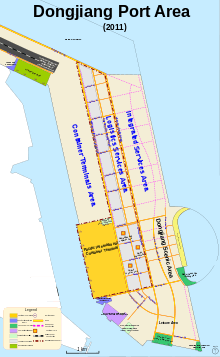
Dongjiang Port Area (Chinese: 东疆港区; pinyin: dōngjiāng gǎngqū; lit.: 'East Border Port Area') lies on an artificial peninsula 10 km long and 3 km wide to the northeast of the main basin, and has an approximate area of 33 km2. This is the newest part of Tianjin Xingang, and is still in development. It includes a new container terminal, a regional logistics center, and a 10 km2 bonded port area (the Dongjiang Bonded Port).
The Dongjiang Port Area is being developed into a comprehensive complex with three parallel zones: the terminal area; a logistic processing zone associated with the bonded port; and a comprehensive service zone, which will include office space, residential space, and shopping and leisure facilities. The leisure area will be centered on the cruiser terminal and yachting piers, and around an artificial beach (the Dongjiang Bay Scenic Area), built with sand imported from Fujian and including a variety of entertainment facilities (including a dragon boat pier).
| Terminal | Port Area | Structure | Berths | Berth Numbers | Quay length | Depth | Quay Cranes | Area | Annual Capacity | Owners | Notes |
|---|---|---|---|---|---|---|---|---|---|---|---|
| Tianjin Port Huicheng General Cargo Terminal[42] (天津港汇盛杂货码头) | General | 4 (2×40,000 DWT; 2×100,000 DWT) | N33-36 | 1075 m | 14–15.5 m | 13 (10×25, 2×40, 1×60 t) | 40 ha | 11 Mt | TPC, KIH | ||
| Tianjin Port Pacific International Container Terminal (天津港太平洋国际集装箱码头)[43] | Container | 6×150,000 DWT) | D1-6 | 2,300 m | 16 m | 23 (65 t) | 218 ha | 4 M TEU | PSA International; TPC | ||
| Dongjiang Construction Materials Terminal[44] (东疆建材码头) | Bulk | 1×10,000 DWT | Dongjiang Kuangjian | 212 m | 10 m | 5 | 2 ha | 1.3 Mt | TPC | Sea sand and stone | |
| Dongjiang MSA Comprehensive Supervision Base (东疆海事综合监管基地)[45] | Patrol | 1×3,000 gt[46] | ? | 200 m | ? | n/a | 2 ha | n/a | Tianjin MSA | UAV ramp.[47] Under construction | |
| Binhai Ocean One International Yachting Club (滨海一洋国际游艇会心) [48] | Passenger | 700+200 | ? | ? | ? | n/a | 5 ha | ? | Under Construction | ||
| Tianjin International Cruiser Homeport (天津国际邮轮母港)[49] | 高桩梁板 | Passenger | 2×200,000 DWT (6 planned) | Y1-2 | 625 m (2,000 m planned) | 11.5 m | n/a | 8 ha | 500,000 passengers | TPC; CMHK[50] | |
| Tianjin Port Dongjiang Development Memorial Park Hydraulic Engineering Wharf (天津港东疆建设开发纪念公园水工码头)[51] | ? | Service | ? | ? | 78 m | ? | n/a | 40.9 ha | n/a | TPG |
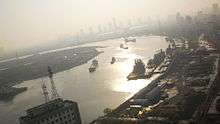
Haihe Port Area
The Haihe Port Area (Chinese: 海河港区; pinyin: hǎihé gǎngqū) operates all river docks from the Xingang Shipping Lock up to the Haihe Second Tidal Barrier, a distance of 39.5 km. Once the core of the Tanggu port, the lower Haihe river area has seen diminishing number of wharves as riverfront real estate has been reassigned for development. In 2003, the Haihe Port Area had 7,100 m of quayside, 83 berths, 56 production berths dealing with all sorts of cargo including containers.[52] The start of the work on the new Tanggu CBD, however, meant the demolition of most facilities in the Xiangguowan, Yujiapu and Lanjingdao peninsulas, including the large Third Stevedoring Company terminal in Yujiapu, which closed in 2009.

This wind-down of activity is still continuing, and on January 1, 2012, the Haihe will be downgraded from a category I waterway into a category IV, limited to vessels under 1,000 DWT and 10 m of air draft (which will permit the extensive bridge construction planned for the lower Haihe).[53] This change will effectively close the river to seagoing vessels, and limit Haihe traffic to barges. Nevertheless, industrial expansion further up the river will lead to a recovery in the number of available berths. Current plans call for six different production areas, with an area of 9.7 km2 and a quayside length of 21 km.[54]
| Terminal | Structure | Type | Berths | Berth Number | Quay length | Depth | Quay Cranes | Area | Annual Capacity | Owner | Notes |
|---|---|---|---|---|---|---|---|---|---|---|---|
| Xingang Shiplock Navigation Wharves (新港船闸导航码头) | Service | n/a | ? | 261.8 m (84.3+177.5 m) | 2.9–4.7 m | 0 | 0 | n/a | Two service wharves at both sides of shiplock | ||
| First Harbor Engineering First Company Boat Section | Service | ? | ? | 137 m | ? | ? | ? | FHE | 2 additional barge slips | ||
| Tianjin Port Well Yield Logistics Terminal (天津中港伟业物流码头)[55] | Multi-Purpose | 4 (3,000 DWT) | sihao matou | 120+360 m | 5.5 m | 8 inch loading arm | 30 ha | ? | |||
| MSA AtoN Tanggu Wharf (天津海事局海标处塘沽码头) | ? | Patrol | ? | ? | 117 m | 4 m | n/a | ? | n/a | TJMSA | Notes |
| Tug & Lighter Company Haihe Wharf (驳船公司海河码头 | 单锚钢筋混凝土板桩 | Service | ? | ? | 151.6 m | 4 m | n/a | ? | n/a | TJTLC | |
| Yongtai Wharf (永泰码头),[56] | 预应力钢筋混凝土高桩大板栈桥结构 | Service | ? | Yongtai | 131 m | 4 m | n/a | ? | n/a | Being decommissioned | |
| Sinotrans Yujiapu Terminal (外运于家堡码头) | 高桩无梁 | General | 1×5,000 DWT | Waiyun | 102 m+50m | 4.5 m | 0 | ? | n/a | Being decommissioned | |
| Jinghai Petrochemical 908 Wharf[57] (京海石化油脂908码头) | Bulk Liquid | 2 (5,000; 3,000 DWT) | T1-2 | 137+55 m | 6-5.5 m | 10 loading arms (160 t/hr) | ? | ? | |||
| Hebei Maritime Transport Terminal (河北海运码头) | Bulk Liquid | 2 | Shuixian | 145 m | 6 m | 3,000 m | ? | ? | |||
| Target Towing Detachment Tangu Wharf (拖靶队塘沽码头) | 高桩无梁大板栈桥 | Patrol | ? | ? | 73 m | 4 m | n/a | ? | n/a | PLAN | Notes |
| Border Troops Tanggu Wharf (边防塘沽码头) | 高桩梁板 | Patrol | ? | 136m | 4m | n/a | ? | n/a | Binhai Border Guards | Used by CG, FLEC and CII. | |
| Dagu Chemical Co. Liquid Chemical Terminal (大化丙烯液碱码头)[58] | 高桩承台 | Liquid Bulk | 3 (1×5,000; 1×3,000; 1×1,000 DWT) | Dahua 1–2 | 130+101+48 m | 5.6 m | ? | ? | ? | Propylene, Liquid Lye and Calcium Carbide terminals | |
| Tianlong Liquid Chemical Co. Terminal (天津天龙液体化工储运码头) [59] | Liquid Bulk | 1×3,000 DWT | Tianlong | 120 m | 5 m | ? | ? | ? | DCG | ||
| Tianjin Binhai Alliance Petrochemical Terminal[60] (天津滨海联合石化物流码头) | Liquid Bulk | 2×3,000 DWT | Binhai Shihua East/West | 142.1 m | 3.9 m | 4 (?) | 30 ha | ? | |||
| North Sea Oil and Grain Company Terminal (北海粮油储炼厂码头) | 钢筋混凝土高土桩承台 | Liquid Bulk | 2 (3,000 DWT) | Beihai Liangyou | 185+100 m | 6 m | ? | ? | ? | COFCO | |
| Tianjin Huagang Logistics Co. Terminal (天津华港物流杂货码头) [61] | 高桩墩台式结构 | General | 3 (2×5,000; 1×3,500 DWT) | Huagang 1–3 | 384 m | 5 m | 5 | ? | ? | Serving the Beihai ceramics market | |
| Sinotrans Tianjin Xinhe Distribution Terminal (中国外运天津集团新河储运码头)[62] | 高桩梁板结构 | General | 5 (3,000 DWT) | Xinhewaiyun 1–5 | 488 m | 6 m | 9 (15 t) | 10 ha | ? | ? | 外运新河 |
| Tianjin Tiande Logistics Company Terminal (天津天德物流码头)[63] | General | 2 (3000 DWT) | Tiande 1–2 | 126.5 m+129m | 6.2 m | 6 (2×40 t; 4×16 t) | 6 ha | 5.5 Mt | |||
| Xinhe Oil Storage and Distribution Center Terminal (新河储油所码头) | Oil | 1 (3,000 DWT) | Xinhechuyou | 123 m | 6 m | ? | ? | ? | |||
| Great Wall Lubricants Terminal[64] (长城滑油码头) | 钢筋混凝土高桩无梁大板Open high pile | Oil | 1 (5,000 DWT) | Changcheng | 120 m | 5.6 m | ? | ? | Sinolube | 新河储油所 | |
| Second Barrier Water Conservancy Wharf (二道闸水利码头) | ? | Dredging | ? | ? | 88 m | 4.5 m | 0 | ? | n/a | ||
| Tianjin Shangyuan Terminal (天津上源码头港业公司码头) | Bulk | 1 (3,000 DWT) | Shangyuan | 97 m | 4.8 m | 2 | ? | ? | Servicing the Chaori Power Plant. | ||
| Goods and Materials Cooperation Terminal[65] (物资协作码头) | Bulk | 1 | Wuzixiezuo | 120 m | 5 m | 2 | ? | ? | |||
| Zhengjiatai Terminal (郑家台码头) [66] | 钢筋混凝土板桩 | Bulk | 4 (2×2,000, 1×3,000,1×3,500 DWT ) | Zhengjiatai 1–4 | 404 m | 5 m | 5 | 12.1 ha | 3.6 Mt | TPC | Construction materials |
Beitang Port Area
The Beitang Port Area (Chinese: 北塘港区; pinyin: běitáng gǎngqū) lies on both sides of the Beitangkou estuary. At present it is limited to several small barge wharves, but it is planned to expand as part of the development of the Binhai Tourism Area. There are two service wharves planned, 230 m and 150 m in length, plus a large environmental monitoring base, passenger terminal, construction materials wharves and yachting marina. The Beitang Fishing Harbor is directly north, inside the river estuary.
Dagukou Port Area
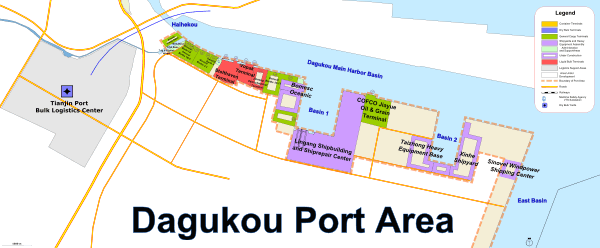
The Dagukou Port Area (Chinese: 大沽口港区; pinyin: dàgūkǒu gǎngqū) lies on the southern side of the Haihe river mouth. It is composed of the wharves of the Tianjin Lingang Harbor Economic Zone (Chinese: 天津临港经济区; pinyin: tiānjīn língǎng jīngjìqū), which is a large industrial area being constructed on reclaimed land. The Dagukou port area is expanding fast, and it is expected to reach a capacity of 100 Mt per year by 2015. Further up the Haihe estuary is the Donggu Fishing Port, which still moors 400 (mostly small) fishing boats.[67]
| Terminal | Structure | Type | Berths | Berth Numbers | Quay length | Depth | Quay Cranes | Area | Annual Capacity | Owner | Notes |
|---|---|---|---|---|---|---|---|---|---|---|---|
| Haihe Estuary Flood Prevention Dredging Wharf (海河口防汛疏浚码头 ) [68] | ? | Dredging | ? | ? | 280 m | ? | n/a | ? | n/a | Haihe Water Conservancy | Being converted for MSA service. |
| Donggu Fishing Harbor Wharf (东沽渔港)[69] | ? | Fishing | 200 (4 wharves) | ? | 400 m | 2 m | ? | ? | ? | ||
| Tianjin Binhai Enesis Trade Base (天津滨海格赛斯贸易基地) [70] | ? | General | 1×2,000 DWT | ? | 500 m | 7.8 m | Quay Cranes | 2.3 ha | ? | Enesis | Cold Chain & Livestock. Under Construction |
| Lingang General Berth 1A (天津港临 1A 通用泊位)[71] | Marginal High Pile Beam & Slab (顺岸高桩梁板结构) | General | 1×50,000 DWT | L1A | 200 m | 11 m | Quay Cranes | ? | ? | LHAC | Specialized Cement |
| Tianjin Lingang 1B-C Berths (天津港临 1B~C 泊位)[72] | ? | General | 2×20,000 DWT | L1B-C | 370 m | 11 m | 3 | ? | ? | LHAC | |
| Tianjin Lingang General Berths No.2 & No.3 (天津港临2~3通用泊位)[73] | ? | General | 2×50,000 DWT | 479 m | 7.8 m | ? | ? | LHAC | |||
| Tianjin Lingang General Berth 4 (天津港临4通用泊位) | ? | General | 1×20,000 DWT | L4 | 220 m | 11 m | 3 | ? | 1.24 Mt | LHAC | |
| Stolthaven Tianjin Chemical Terminal (天津思多而特临港仓储?) [74] | ? | Oil | 2 (1×20,000; 1×60,000 DWT) | L5-6 | 330+365 m | 10.5–14 m | ? | 13 ha | ? | SNTG, LHAC | |
| Lingang Vopak Terminal (临港孚宝码头) [75] | Offshore Marginal Narrow Platform High Pile Beam & Slab (离岸式窄承台高桩梁板码头结构) | Liquid Chemical & Oil | 2×50,000 DWT | Berth L7-8 | 604 m | 14 m | ? | 62 ha | 3.75 Mt | KVNV, BCIG, TJNP | Activated in January 2012[76] |
| Tianjin Lingang Jinneng Petrochemical Terminal (天津临港津能石化码头有限公司) [77] | ? | Liquid Chemical & Oil | 1×50,000 DWT) | L9 | 298 m | ? | ? | ? | Annual Capacity | Jinneng | Under Construction |
| Tianjin Dagukou General Berths 10–11 (天津港大沽口港区10-11#通用泊位码头)[78] | ? | General | 2×70,000 DWT | L10-11 | 521 m | 15 m | ? | ? | 4.2 Mt | LHAC | |
| Tianjin Lingang General Berth 18 (天津港临港工业港区18号通用泊位)[79] | ? | General | 1×20,000 DWT | L18 | 260.5 m | ? | ? | 20 ha | 900,000 t | LHAC | Under Construction |
| Dagukou Bomesc Oceanic Heavy Industry Construction Base Wharf (大沽口港区博迈科海洋重工建造基地码头)[80] | ? | Components Transfer and Fitting | 2 (1×6,000 DWT; 1×3,000 DWT) | ? | 250 m | ? | ? | ? | ? | CCCC | |
| Tianjin Lingang Shipbuilding Base Fitting Wharf #1 and Materials Wharf (中船重工天津临港造修船基地造船区1#舾装及材料码头)[81] | ? | Fitting, Materials | 2 (1×300,000 DWT,1×5,000 DWT) | ? | 707+150 m | 9 m | ? | ? | ? | CSIC | |
| Cofco Jiayue Grains & Oil Terminal (天津临港佳悦油码头)[82] | ? | Dry & Liquid Bulk | 3 (1×70,000; 2×100,000 DWT) | Liangyou 1–3 | 310 m (berth 1) | 16 m | ? | 30 ha | 6 Mt | COFCO; BGG;SMG | Berths 2–3 Under Construction |
| Sinovel Windpower Tianjin Lingang Shipping Base (华锐风电天津临港装运基地) [83] | High Pile | Equipment | 4×5,000 DWT | ? | 520 m | ? | ? | 24.8 ha | ? | Sinovel | Under Construction |
Port fairway
The Tianjin Xingang Fairway is divided into the Main Shipping Channel, the Chuanzhadong Channel, and the Northern Branch Channel. The Dagusha Channel and the Haihe river channel are separate fairways with slightly different regulations.
Shipping channels
- The Main shipping channel (新港主航道) is 39.5 km long. The channel extends from the gate line of the VTS control area (20 nautical miles (37 km) from the VTS control tower), up to the start of the Chuanzhadong Channel.[note 1] Since November 2010, the Main Channel has been dredged to a depth of −19.5 m and a bottom width of 420 m, making it capable of handling two-way 250,000 DWT traffic, and to accept 300,000 DWT ships at high tide. There are two service channels (100 m wide and 9 m deep) at each side of the main channel, which allow ships under 10,000 DWT (i.e. service craft, barges and coastal ships) to transit without interference from the big ships. The breakwater mouth was expanded to 1,100 m wide in 2010.[84] As of 2012, the Main Channel is being deepened to 22 m and widened to 765 m, which will allow two-way all-tide traffic of 300,000 DWT ships by 2013.[85]
- The Chuanzhadong channel (船闸东航道), called "Chuanzha channel" in Admiralty charts, starts roughly at the level of the Second Pier and ends at the Xingang Shipping Lock, a total of around 4.5 km. Its depth varies between 10 m to 5 m as it approaches the shiplock.
- The Northern Harbor Branch Channel (北港支航道) extends from its bifurcation from the main channel up to the northern end of the basin, approximately 6.5 km. It has been dredged all the way to the end of the basin (where the Huicheng terminal lies) to a depth of 15 m and a width of between 190 m to 390 m. Its junction with the Main Channel was widened to 765 m in 2007 to facilitate traffic merging.
The Dagusha Channel (大沽沙航道) is wholly separate from the Main Channel. It is 27.5 km long from safe water (12 m isobath) to the mouth of the Haihe. It was upgraded in December 2010 to a depth of 12.3 m, 180 m wide, for a one-way traffic capacity of 50,000 DWT (100,000 DWT in high tide). Current dredging is expanding the Channel to 230 m bottom width and 14 m depth, which will allow all-tide traffic of 100,000 DWT vessels.[86] The long-term plan is to dredge the Channel up to a two-way 200,000 DWT capability.
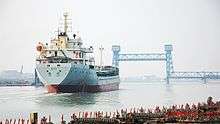
The Haihe River Channel varies in depth between 4 m to 8 m with a minimum bottom width of 50 m and a maximum of 120 m. It can handle vessels of up to 5,000 DWT in the section between the Xingang Shiplock and the Haimen Bridge, and up to 3,000 DWT and 31 m air draft from the Haimen Bridge to the Second Tidal Barrier.[87] This capacity will be reduced to 1,000 DWT once the planned fixed bridges in the Haihe are built.
The Beitangkou Channel (北塘口航道) is at present a natural shallow-water buoyed channel capable of handling barges, fishing boats and service vessels of up to 1,000 gt. It is currently being dredged to 7.9 m depth, 190 m width.
The channels serving the other three port areas are being expanded and will become open as said areas become open.[88] The Nangang Channel was activated in July 2011 on a trial basis. At present it extends 19 km[89] and is dredged to a 5,000 DWT capacity (100 m wide, 6.5 m deep). According to plans, it will reach 100,000 DWT capacity by as early as 2015.[90] The Gaoshaling Channel is currently being dredged to 12.5 m depth, 150 m width, for a planned capacity of 50,000 DWT in 2015. The Hangu Channel is being dredged for 16 km to a 7 m depth, 75 m width, for a capacity of 5,000 DWT [91]
A number of secondary channels have been set up and seamarked by the MSA and FLEC to divert small boat traffic away from the main fairways. The "Sand and Gravel Transport Boats Preferred Channel" (天津港砂石运输船舶推荐航路)[92] runs to the south of the Main Channel and the Dagukou anchorages, and is designed to stop the dangerous flow of barges and construction vessels that used to cut across NE-SW, right through the flow of large ships.[93] The Donggu Fishing Port Channel runs north of the Dagusha Channel, close to the Nanjiang island, and separates fishing boats from the deep water channel.
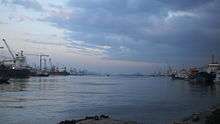
Harbor basins are breakwater-protected, and include the in-harbor Channels and the approaches to the wharves. The Main Harbor Basin extends 16.5 km from the Xingang Shipping Lock to breakwater mouth, and there are four secondary basins within the main basin, formed by the four jutting piers of the Beijiang port area. The North Harbor Basin is 8.5 km long by 1,100–900 m wide, and has two secondary basins (in construction). The Dagukou Harbor Basin is 14 km long, and tapers down from 1,500 to 900 m wide as it goes up the old Haihe mouth. It also has two secondary basins (in construction).
Anchorages
Tianjin Port has six main anchorage areas and two temporary anchorages. All anchorages are designated for all functions—berth waiting, quarantine, inspection and pilotage—, and provide little shelter from weather or rough seas. Bottom hold is poor to very poor, anchored vessels are advised to keep five cables of clearance, as anchor dragging is common (up to 5–10 NM in a day in winter, due to drifting ice).[94]
The Dagukou North, South and Chemical Bulk anchorages are situated on both sides of the main shipping channel, to the east of the Dagu Lighthouse. These anchorages cater for the majority of the traffic, and can get very crowded. Collisions have occurred with some frequency in the past. The two deep water anchorage sites are further out into the deeper parts of the Bohai Bay. One anchorage for very large Capesize vessels of more than 150,000 DWT is shared with Tangshan Caofeidian.
Two more anchorages (No5 and 6) serve the Dagukou area. Both are located on the south side of the Dagusha channel. No6 covers 40 km2, has depth of 10–13 m and anchors small and medium displacement vessels. No5 anchorage covers 20 km2 and has a depth of 16–18 m, anchoring larger vessels.[95] No6 anchorage is operational but still little used, No5 was recently activated (2011) but it is still considered "temporary". The most recent temporary anchorage serves the newly opened (2011) Nangang area. Finally, there is a "Zhengjiatai Lay-By Berthing Area" (郑家台临时候泊区) on the Haihe, next to the Second Barrier[96] for ships awaiting berths at the Zhengjiatai terminal.
| Name | Location | Depth | Bottom | DWT Anchorable | Purpose |
|---|---|---|---|---|---|
| North Dagukou Anchorage (沽口北锚锚地)(No1 Anchorage) | * 38°59"24'N/117°58"18'E * 38°58"01'N/118°07"04'E * 38°56"57'N/117°57"39'E * 38°56"33'N/118°06"26'E | 8–13.0 m | Mud | 50,000 DWT | All vessels with drafts of less than 10.5 m, except tankers and chemical bulk carriers. |
| South Dagukou Anchorage (沽口南锚锚地)(No2A Anchorage) | * 38°55"42'N/118°01"14'E * 38°53"26'N/118°00"39'E * 38 °54"54'N/118°06"15'E * 38°52"38'N/118°05"40'E | 12.0–16.0 m | Mud | 50,000 DWT | Dangerous Cargo (Oil, Chemical tankers and bulk carriers) of more than 8.0 m draft, and other cargo ships of over 10.0 m draft but less than 13.0 m. |
| Chemical Bulk Anchorage(大沽口散化锚地) (No2B Anchorage) | * 38°55"42'N/118°01"14' E *38°56"18'N/117°57"29'E * 38°53"26'N/118°00"39'E * 38°54"02'N/117°56"54' E | 10.0 m | Mud | 50,000 DWT | Tankers and bulk chemical carriers of less than 8.00 m draft. |
| 100,000 DWT Anchorage (十万吨级锚地) (No3 Anchorage) | *38°51"49.446'N/118°10"18.033'E *38°49"43.474'N/118°13"53.163'E * 38°48"07.35'N/118°12"21.13'E *38°50"13.27'N/118°08"46.03'E | 18.0 m | Mud | 100,000 DWT | Vessels of draft over 13.0 m |
| Tianjin and Caofeidian Large Vessel Anchorage (天津港和唐山港曹妃甸港区大型船舶锚地) (No4 Anchorage)[97] | *38°53′62″N/118°24′66″E 38°53′43″N/118°26′43″E 38°52′06″N/118°27′28″E 38°52′36″N/118°23′85″E |
23–28 m | Mud | 300,000 DWT | For very large tankers and bulk carriers. Shared between Tianjin and Tangshan Caofeidian. |
| Tianjin Lingang No5 Anchorage (5号临时锚地)[98] | *38°42'.13 N/118°13'.06E *38°39'.72 N/118°17'.13E *38°38'.12 N/118°15'.59E *38°40'.53 N/118°11.53'E | 16–18 m | Mud | 100,000 DWT | Temporary Anchorage Area |
| Tianjin Lingang No6 Anchorage (6号临时锚地)[99][100] | 38°49.56'N/118°00.48'E 38°48.35'N/118°02.50'E 38°47.50'N/118°01.75'E 38°48.75'N/117°59.72'E | 12 m[101] | Mud | 50,000 DWT | |
| Tianjin Nangang Industrial Area Temporary Anchorage(天津南港工业区临时锚地)[102] | 38°44′58″.0 N/117°56′03″.0E 38°44′55″.0 N/118°02′57″.0E 38°43′17″.5 N/118°02′55″.5E 38°43′21″.0 N/117°56′01″.5E | 9.0–12.5 m | Mud | Temporary, opened in 2011 | |
| Zhengjiatai Lay-By Berthing Area(郑家台临时候泊区)[103] | 39°01′04″.0 N/117°27′35″.0 E 39°01′00″.0 N/117°27′40″.0 E 39°00′58″.0 N/117°27′39″.0 E 39°01′01″.0N/117°27′33″.0E | 5.6 m | Mud |
Shiplocks and tidal barriers
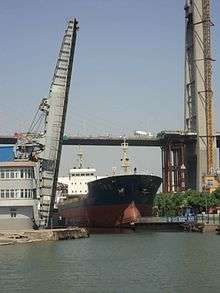
The Haihe river channel is separated from the sea channels by three structures: First, the Xingang Shiplock (Chinese: 新港船闸; pinyin: xīngǎng chuánzhá) in the northern side of the estuary is the main shipping route into the Haihe area. It was started by the Japanese occupation forces in 1942, completed in 1943 and made operational by the Nationalist government after the war, in 1946. It has a width of 20.5 m, a length of 180 m and cill depth of 5 m. It allows passage to vessels up to 18.5 m wide, limited to 17.5 m at night and for ships carrying liquid bulk or otherwise dangerous cargoes. The Haihe Bridge is directly over the shiplock, with an air clearance of 39.5 m.
Second, the Haihe Tidal Barrier (Chinese: 海河防潮闸; pinyin: hǎihé fángcháozhá), built in 1958, and last refurbished in 1999, serves as a dam, flood control sluice and tide surge protection for the Haihe river mouth. It is an open sluice design, with 8 vertical-rising gates designed for an average flow of 1,200 m3/s flow when open, with a maximum flow of 1,689 m3/s recorded on 28 August 1963.[104]
Third, the Tanggu Fishing Boat Lock (Chinese: 塘沽渔船闸; pinyin: tánggū yúchuánzhá) is located at the western end of the channel between Donggu and Lanjingdao Island. Built in 1959, it is 150 m long, 14 m wide, 8 m ditch depth, with cill water depth of 2.5 m. It can handle ships of up to 200 gt.[105] In 2011, the Fishing Boat Lock gates started to be rebuilt to allow for larger road traffic between Donggu and Lanjingdao.[106]
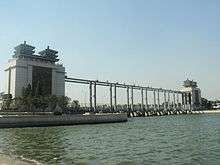
The final hydraulic structure of the Tianjin Port is the Haihe Second Barrier (Chinese: 海河二道闸; pinyin: hǎihé èrdàozhá) at Dongnigucun, in the Jinnan district. The Second Barrier is also an open-type sluice barrier, with 8 vertical-rising gates allowing an average flow of 1200 m3/s. The Barrier, opened in July 1984, closes ship traffic upriver into Tianjin city proper, and its erection resulted in the abandonment of 29.3 km of navigable channel.[107]
Port areas under development
The last three areas (Gaoshaling, Nangang, Hangu) are under construction, and will be integrated into Port operations as they come online.[108]
Hangu Port Area (Chinese: 汉沽港区; pinyin: hàngū gǎngqū) comprises the Tianjin Central Fishing Port (天津中心渔港), which is located at Caijiabao (蔡家堡) to the north of Beitang. The Central Fishing Port is a large (18 km2) mixed development that gathers tourist facilities, a yachting marina, a fishing port with 17 berths capable of handling ships up to 5,000 DWT for a throughput of 17 million tonnes,[109] and cold-chain warehousing. It is expected to go into full operation in 2012–13.
Gaoshaling Port Area (Chinese: 高沙岭港区; pinyin: gāoshālǐng gǎngqū) is located on reclaimed land to the south of the Lingang Industrial Area and north of the Duliujian (独流减) river. It includes the docks of the southern section of the Lingang Economic Area, and will have its own channel. Gaoshaling area will focus on heavy equipment handling and other heavy industrial cargo.[110] The
Nangang Port Area (Chinese: 南港港区; pinyin: nángǎng gǎngqū) is being built on the reclaimed land of the TEDA Nangang Industrial Zone (天津开发区南港工业区), south of the Duliujian river and north of the Ziya river. It will focus at first on petrochemical goods. The first trial wharf opened in 2011.
Geophysical setting
Geology
The coastal area of Tianjin municipality prior to development was dominated by mudflats, salt marshes (and salterns), and coastal shallows. This littoral zone is wide and slopes gently: the 0 m isobath (the intertidal flats) extends to 3–8 km from shore at a slope of 0.71–1.28%, the −5 m isobath extends 14–18 km from shore, and the −10 m isobath reaches 22–36 km from shore. These features make deep water navigation dependent on extensive dredging, but it also means that land reclamation is a cost-effective option for construction. Tianjin Port is thus by necessity largely man-made through dredging and reclamation.
Soil geology: As it is largely built on man-made surfaces, Tianjin Port’s engineering geology is fairly regular:
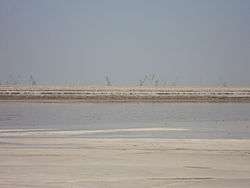
- A layer of artificial fill from +4.6 m to +2.0 m of elevation. On older parts of the Port, this layer was placed by jetting dredged material, which made the dredged silty clay finer. More recent construction uses the vacuum preloading method, which results in better compacted surfaces.
- A layer of marine deposits of silt and silty clay interspersed with sand, of recent date (~800 years BP). It is around 15 m thick, highly waterlogged, and considered a risk to liquefy during an earthquake.
- A layer of alluvial deposit of the Holocene estuary delta. This is mostly cohesive soil (silty clay) and silty sand, horizontally stratified. At −21 m there is a dense layer of fine sand, which provides good support for piles and foundations.[111] although in newer construction, piling usually extends to −36 m or beyond. Bedrock is not reached at engineering depths (shallowest seams are 180 m[112])
Seismological Conditions: The area of Tianjin is very seismically active. The 1976 Tangshan earthquake affected the harbor and caused serious damage to its installations.[111] The Port's current design specifications are to resist earthquakes of intensity 7, to a basic design Peak ground acceleration of 0.15 g.
Meteorological conditions
| Tanggu | ||||||||||||||||||||||||||||||||||||||||||||||||||||||||||||
|---|---|---|---|---|---|---|---|---|---|---|---|---|---|---|---|---|---|---|---|---|---|---|---|---|---|---|---|---|---|---|---|---|---|---|---|---|---|---|---|---|---|---|---|---|---|---|---|---|---|---|---|---|---|---|---|---|---|---|---|---|
| Climate chart (explanation) | ||||||||||||||||||||||||||||||||||||||||||||||||||||||||||||
| ||||||||||||||||||||||||||||||||||||||||||||||||||||||||||||
| ||||||||||||||||||||||||||||||||||||||||||||||||||||||||||||
Climate: Tianjin Port is at the northern limit of the continental monsoon climate area. Specifically, it belongs to the temperate semi-humid continental climate type (Köppen Dwa), with a short rainy season in the summer, large seasonal differences in temperature, and large variation in weather year to year. Annual average temperature is 12.3 °C (54.1 °F). The hottest months are July and August (maximum temperature recorded was 39.9 °C or 103.8 °F on 24 July 1955), and the coldest is January (minimum temperature recorded was −18.3 °C or −0.9 °F on 17 January 1953). The average relative humidity is 65%, with a maximum of 100% recorded in summer, and a minimum of 3% recorded in winter.
Precipitation and Storms Average annual precipitation is 602.9 mm (23.7 in), with rainfall concentrated on the rainy months of July and August. Maximum recorded annual rainfall was in 1964 (1,083.5 mm), and minimum recorded annual rainfall was in 1968 (278.4 mm). The maximum single day precipitation recorded occurred on 30 July 1975 (191.5 mm). The average number of thunderstorms is 27.5 per year, mostly breaking out in June and July. Due to its shallowness and narrowness, the Tianjin coast is prone to storm surges: since 1860 there has been 30 storm surges, around once every 4 years, most recently in 2003, 2009 and 2011. Of the nine serious surges in the last hundred years, five were caused by typhoons (the Bohai Bay is at the northernmost range of the Pacific typhoon corridor), and four by winter cyclones.[113]
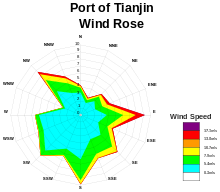
Winds: Average annual wind velocity is 4.43 m/s; Easterly winds have the fastest average velocity, averaging 6.51 m/s. Strongest (steady) wind recorded was a WNW blowing at 33 m/s, on 3 January 1986.[114] Winds over category 7 are observed for 1–7% of the year. Predominant winds are:
- Spring: SW
- Summer: SE
- Autumn: SW
- Winter: NW

Fog: Fog or haze is present around one third of the year, particularly during winter. Of these hazy days, there is an average of 16.5 fog days per year with visibility of less than one kilometer (a visibility level that triggers severe restriction of traffic in the port). The foggiest year on record was 1972, with 26 days; foggiest month was January 1973 with 12 days.[22] Like other regions in the North China Plain, Tianjin Port is prone to pollution haze. This haze can be a navigational problem when combined with foggy conditions.[115]
Hydrology
The Bohai Bay is one of the three bays that compose the Bohai Sea. The Bay is a semi-enclosed, fairly shallow water basin, with average depth below 10 m. It has relatively poor water exchange into the Bohai Sea,[116] and in turn the Bohai Sea exchanges poorly with the Yellow Sea (it can take 40 to 200 years for complete water turnaround[117]), which means that both silt and pollution runoff accumulates in the Bay.[118]
Tides: Tanggu has a mixed semidiurnal tide. The lunitidal interval is 45 min, the average duration of rise is 5 h 40 min, and the average duration of fall is 6 h 53 min.[119] The daily inequality between low waters is particularly marked.[120] Average tide heights at the Tanggu Oceanic Station (塘沽海洋站) are:[note 2]
- Mean Sea Level: 2.56 m
- Mean High Water (MHW): 3.74 m
- Mean Higher High Water (MHHW – Admiralty Datum): 3.7 m
- Mean Lower High Water (MLHW – Admiralty Datum): 3.6 m
- Mean Low Water (MLW): 1.34 m
- Mean Higher Low Water (MHLW – Admiralty Datum): 1.7 m
- Mean Lower Low Water (MLLW – Admiralty Datum): 0.7 m
- Mean Tidal Range: 2.47 m
- Mean Tidal Range Springs: 3.5 m (NGA approximation)
- Mean Tidal Range Neaps: 2 m (NGA approximation)
- Maximum High Tide Recorded: 5.83 m(September 1992)
- Minimum Low Tide Recorded: −1.08 m (18 December 1957)
- Maximum Tidal Range Recorded: 4.37 m (26 October 1980)
| Constituent | Species | Amplitude (H) | Phase (φ) |
|---|---|---|---|
| M2 | Lunar Semidiurnal | 117 cm | 90°/hr |
| S2 | Solar Semidiurnal | 34 cm | 165°/hr |
| K1 | Lunar Diurnal | 36 cm | 154°/hr |
| O1 | Lunar Diurnal | 27 cm | 99°/hr |
| (HO1 + HK1) / HM2 = 0.53.[122] | |||

The design water levels for port facilities are:[123]
- Design high water level: 4.30 m
- Design low water level: 0.50 m
- Extreme high water level: 5.88 m
- Extreme low water level: -1.29 m
Tidal currents: Flood tide at the Dagukou Anchorage flows northwest (average bearing 292°), at an average speed of 0.8 knots, and a maximum of 1.9 knots. Ebbing tide flows to the southeast (130° average bearing), at an average speed of 0.7 knots, and a maximum of 1 knot. Tide currents within breakwaters are parallel to the channel and have a maximum speed of 0.64 knots.[124]
Waves:
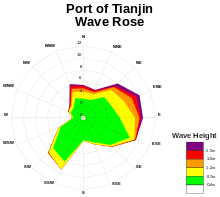
The western Bohai Bay is a relatively calm body of water. The frequency of waves below 1.0 m height is 87.6%, of waves of height above 1.0 m is 12.4%, waves above 2.0 m is 1.9% and waves above 3.0 m is 0.4%.[125] The proportion of pure wind waves is 74.2%, of pure swell waves is 0.9%, and of mixed swell/wind is 24.9%. Predominant wave directions are NNE-E (9.68% frequency), ENE-E (9.53%) S (9.27%), SSE (8.91%) and SE (8.30%).[126] Waves are strongest in spring and weakest in fall. Summers are very calm, unless typhoons wander off far enough north. Strongest average waves are ENE and NNW waves.[127]
Icing: Ice cover in the Bohai Bay is highest in February. Shore icing extends an average of 500 m, with an average thickness of 10–25 cm, maximum of 40 cm. Drift ice extends 15–20 nm, roughly to the 10–15 m isobath. Average drift ice thickness is around 5 cm, maximum thickness is 20–25 cm. Ice flows are SE–NW, at an average speed of 30 cm/s, maximum of 100 cm/s.[128] Icing is a regular problem for the Haihe river port area, and requires continuous clearing.[129] Icing is not normally a navigational hazard at the seaport, except on extremely severe winters like the 2009–2010 winter (the severest in over 30 years). Seasonal buoyage change is necessary.
Sedimentation: Silting was long considered an insurmountable obstacle to deep-water navigation at Tanggu. However, the extensive hydraulic work of the last decades, in particular the damming of the Haihe, has reduced silting to manageable levels, reducing average estuary water sediment from 0.75 kg/m3 to 0.1 kg/m3[125][130]
Pollution: Severe eutrophication caused by polluted runoff has made red tides in the Bohai Bay common. Combined with overfishing, this has put pressure on once-abundant fish stocks. Biological pollution is also a problem, with illegal ballast water discharges creating a strong danger of invasive exotic species.[131] Habitat destruction caused by reclamation has damaged coastal wetlands, intertidal flats and shallow water hatcheries essential for many fish and bird species.[132]
Notes
- Since 2008, the Main Channel incorporates the old "Dengtabei Channel" that still appears in older charts as extending from the Dagu Lighthouse to safe water
- The Chart datum used for these tide values is the 1985 National Datum Mark (国家高程基准), which is an adjustment of the 1956 Yellow Sea Datum. The Admiralty chart datum uses the local LAT, and the NGA presents approximate data, so the numbers disagree slightly. The old "Dagu Zero" (大沽零点), the first of the six Chinese chart datums, was developed at the Dagu tide station and it is sometimes still found in some older charts (particularly of the Haihe). Archived 2008-11-21 at the Wayback Machine Dagu Zero is 1.163 m higher than the 1985 Datum.
References
- "天津港口章程 (Tianjin Port Articles of Incorporation)". 天津市交通委员会 (Tianjin Municipal Transport Commission). May 2006. Archived from the original on 2012-04-26. Retrieved 2012-01-05.
- "天津港第一港埠有限公司公司简介". Tianjin Port First Stevedoring Co. Archived from the original on 2012-04-26. Retrieved 2012-03-03.
- "1997年滨海新区大事记". 滨海新区网 Binhai New Area Network. 2009-09-25. Archived from the original on 2012-04-26. Retrieved 2012-03-03.
- "天津港第二港埠有限公司-企业介绍". Tianjin Port Second Stevedoring Company. Retrieved 2012-03-03.
- "津海事(2011)航字第103号 天津港北疆7、8号泊位码头改造升级后开通使用". Tianjin MSA. 2011-11-15. Retrieved 2012-03-03.
- http://www.msa.gov.cn/Notice/Notice/9ee53990-cdfc-4105-b271-e52dae08954f
- "欢迎进入天津港务局四公司网站-公司概况". Tianjin Port Fourth Stevedoring Company. Archived from the original on 2012-04-26. Retrieved 2012-03-03.
- "中国沿海港口航道图改正通告 第34期(总第567期)" (PDF). China Maritime Safety Administration. Archived from the original (PDF) on 2015-09-24. Retrieved 2012-09-06.
- "天津港第五港埠有限公司介绍". Ptacn.com. Archived from the original on 2011-09-02. Retrieved 2012-03-03.
- "天津地方志网". Tjdfz.org.cn. Retrieved 2012-03-03.
- "天津港集装箱码头有限公司简介". 天津港集装箱码头有限公司 (Tianjin Container Terminal Co.). Retrieved 2012-03-03.
- "天津东方海陆集装箱码头有限公司". Toct.com.cn. Archived from the original on 2012-04-26. Retrieved 2012-03-03.
- "天津港东突堤工作船码头竣工-" (2008年01期). 《水道港口》. January 2008. Retrieved 2012-03-03. Cite journal requires
|journal=(help) - "五洲简介". 五洲国际集装箱Pie. Retrieved 2012-03-08.
- "首页 – 公司介绍". 天津港滚装码头有限公司. Archived from the original on 2012-04-26. Retrieved 2012-03-08.
- "About Us". 天津港联盟国际集装箱码头有限公司(Tianjin Alliance Container Terminal). Retrieved 2012-03-08.
- "About Us". 天津港欧亚国际集装箱码头有限公司 (Tianjin Port Euroasia Intl Container Terminal). Retrieved 2012-03-08.
- "北港池集装箱8–10#泊位项目签约". 天津港股份有限公司. 2008-12-12. Archived from the original on 2012-04-26. Retrieved 2012-03-08.
- "关于中船重工天津临港造修船基地1#码头等临时卸砂码头验收情况的通告". Tianjin MSA. 2010-08-01. Retrieved 2012-03-08.
- "Terminal services – Tianjin". Wallenius Wilhelmsen Logistics. Archived from the original on 2012-03-05. Retrieved 2012-03-08.
- "天津港海景游". 天津津旅海河游船有限公司. 2011-06-20. Archived from the original on 2012-04-14. Retrieved 2012-03-08.
- "天津基地". 交通运输部北海救助局 (Beihai Rescue Bureau). Archived from the original on 2011-09-10. Retrieved 2011-12-10.
- "天津北方港航石化码头改造工程通过验收". 天津航道局 (Tianjin Dredgins Co). 2011-12-12. Archived from the original on 2012-07-23. Retrieved 2012-03-08.
- "[建筑设计] 天津港南疆东部港区北围埝出石料码头工程". Soubaoba.com.cn. 1989-12-21. Retrieved 2012-03-08.
- "工程名称: 中港一航局一公司南疆新建预应力预制构件场工程 工程编号: 059". 中交天津港湾工程设计院有限公司 (Tianjin Port Engineering & Consulting Company Ltd. of CCCC First Harbor Engineering Company). Retrieved 2012-03-04.
- "公司风采". 天津港第三港埠公司. Archived from the original on 2008-09-07. Retrieved 2012-03-08.
- "码头设施". 天津港石油化工码头有限公司 (TPPTC). Archived from the original on 2011-09-02. Retrieved 2012-03-08.
- "公司介绍". 天津港焦炭码头有限公司. Retrieved 2012-03-08.
- "公司简介". 天津港中煤华能煤码头公司. Archived from the original on August 19, 2011. Retrieved 2012-03-08.
- "Notice by Tianjin MSA No. 016 (2009): No.11 Berth in Nanjiang Port Area of Tianjin Port Meets the Requirements". Maritime Safety Administration People's Republic of China. 2009-03-01. Retrieved 2012-03-08.
- "下属主要公司". Tianjin Port Holdings Co., Ltd. Archived from the original on 2009-01-07. Retrieved 2012-03-13.
- "公司领导". 神华集团. 2010-09-28. Archived from the original on 2012-03-08. Retrieved 2012-03-08.
- "天津港南疆专业化矿石码头工程环境影响公示(第二次)". Eiafans Network. 2008-12-30. Retrieved 2012-03-11.
- "南疆专业化矿石码头试桩". 天津港电子报刊. Retrieved 2012-03-08.
- "天津港实华原油码头扩建工程环评第一次公示". Tianjin Port Group. 2012-09-07. Archived from the original on 2012-10-17. Retrieved 2012-10-17.
- "天津港燃油供应2#基地码头工程海洋环评公示(第二次)". 环评爱好者 (Eiafans Network). 2011-07-08. Retrieved 2012-03-10.
- "关于我们 公司简介". 中化天津港石化仓储有限公司. Archived from the original on 2011-07-16. Retrieved 2012-03-10.
- "天津港南疆中国航油石化码头工程". 泛地产业务解决方案平台. 2010-11-01. Archived from the original on 2012-04-26. Retrieved 2012-03-10.
- "共建天津港圣瀚石化码头 提升新区仓储物流能力". 广州港资讯网. 2011-05-09. Retrieved 2012-03-12.
- "天津港圣瀚石化码头工程环评公示(第二次)". Eiafans Network. 2012-03-20. Retrieved 2012-09-06.
- "中国首个浮式液化天然气终端接收项目在天津启动". Reuters. 2012-03-06. Archived from the original on 2015-12-08. Retrieved 2012-03-15.
- "设备设施". 天津港汇盛码头有限公司. Archived from the original on 2013-04-03. Retrieved 2012-03-10.
- "公司简介". 天津港太平洋国际集装箱码头有限公司. Retrieved 2012-03-10.
- "公司风采 东疆建材码头". 天津港第三港埠公司. Archived from the original on 2008-09-07. Retrieved 2012-03-10.
- "天津海事局"十一五"综合发展规划规划计划". Tianjin MSA. 2006-05-01. Retrieved 2012-03-10.
- "津海事(2011)航字第110号 东疆海事监管基地1标段疏浚和码头工程". Tianjin MSA. 2011-12-15. Retrieved 2012-03-10.
- "天津东疆海事综合监管基地开建 快速有力保障海上安全". World Chinese Newspaper Weekly. Archived from the original on 2012-04-26. Retrieved 2012-03-10.
- "Ocean One Project Overview". Ocean One. Retrieved 2012-03-10.
- "Notice by Tianjin MSA No.030 (2011) Y1, Y2 Berths Open at Tianjin International Cruise Terminal". China MSA. 2011-04-20. Retrieved 2012-03-10.
- "天津邮轮产业品牌更加响亮". Star Human Resources. Retrieved 2012-03-10.
- "公司承建的天津港东疆建设开发纪念公园工程通过验收!". 中交第一航务工程局有限公司. 2011-11-16. Archived from the original on 2016-02-04. Retrieved 2012-03-10.
- "天津港第三港埠公司" (8). 中國港口 (China Ports). 2003. Retrieved 2012-01-05. Cite journal requires
|journal=(help) - "海河下游内河航运将弱化 专家称不影响旅游开发". E-North News Network. 2011-12-12. Retrieved 2012-03-10.
- "天津市防治船舶溢油污染海洋环境应急能力建设专项规划编制说明". Tianjin MSA. 2011—17. Retrieved 2012-02-01. Check date values in:
|date=(help) - "中港伟业 >> 走进中港 >> 中港简介". 天津中港伟业物流有限责任公司. Archived from the original on 2012-04-26. Retrieved 2012-03-10.
- "天津港(Port Of Tianjin)". Water Resources News Network. Retrieved 2012-03-10.
- "天津京海石化运销有限责任公司公司简介". 天津市京海石化运销有限公司. Archived from the original on April 26, 2012. Retrieved 2012-03-10.
- "About Us". 天津大沽化工股份有限公司 (Tianjin Dagu Chemical Industry Holdings). Retrieved 2012-03-10.
- "码头:天津天龙液体化工储运有限公司". Dragon Crown Group Holdings Co. Retrieved 2012-03-01.
- "中国沿海港口航道图改正通告第27期(总第376期)" (PDF). 中华人民共和国海事局 (China Maritime Safety Administration). 2008-09-30. Retrieved 2012-03-01. Cite journal requires
|journal=(help) - "华港物流有限公司1#、2#、3#泊位码头工程". 中交第一航务工程局有限公司 (CCCC First Harbor Engineering Company Ltd.). 2010-07-07. Archived from the original on 2016-02-04. Retrieved 2012-03-01.
- "中国外运天津集团新河储运公司". 仓储式在线作品出版平台C. Retrieved 2012-03-10.
- "设备概况". 天津天德物流有限公司. Archived from the original on 2012-04-26. Retrieved 2012-03-10.
- "公司简介 滨海分公司". 中国石化长城润滑油网. Retrieved 2012-03-10.
- "天津市工业物资协作公司". 搜企黄页网. Retrieved 2012-03-10.
- "天津津港军粮城港埠有限公司郑家台码头改造工程". 天津市行政审批服务网. Archived from the original on 2015-12-22. Retrieved 2012-03-10.
- Xiong Zhengnan. "天津港燃油供应2#基地工程与东沽渔港航道通航环境影响论证". Jimei University Navigation Institute. Cite journal requires
|journal=(help) - "海河口防汛疏浚码头工程施工标招标公告". 水信息网 (Water Information Network). 2008-11-24. Archived from the original on 2012-04-26. Retrieved 2012-03-10.
- "沿海地区渔港分布概况(一)". 中国海洋文化在线 (China Ocean Culture Online). 2004-12-18. Retrieved 2012-03-10.
- "中国股权网=>天津滨海格赛斯贸易基地项目重大项目信息详细". 中国股权网 (China Equities Network). 2011-11-15. Retrieved 2012-03-10.
- "关于天津港大沽口港区1A通用泊位限制条件下靠泊能力调整为5万吨级的通告" (PDF). Tianjin MSA. 2013-12-16. Retrieved 2014-01-02.
- "中国沿海港口航道图改正通告第10期(总第439期): 天津港临港1BC泊位正式开通" (PDF). 中国海事局 (China MSA). 2010-03-08. Archived from the original (PDF) on 2015-12-22. Retrieved 2012-03-10.
- "Notice by Tianjin MSA No. 92 (2008): Universal berth No.2 & No.3 of Tianjin Port Industrial Zone open". Maritime Safety Administration of the People's Republic of China. 2008-07-17. Retrieved 2012-03-10.
- ">思多而特仓储>天津". Stolt-Nielsen Limited. Archived from the original on 2012-03-20. Retrieved 2012-03-10.
- "天津临港孚宝码头有限公司". 天津临港港务集团有限公司 (Tianjin Lingang Port Group Co. Ltd. Archived from the original on 2012-09-13. Retrieved 2012-03-10.
- "中国沿海港口航道图改正通告第7期(总第540期) 关于天津港临港工业港区7号、8号液体Det码头开通使用的公告" (PDF). 中国海事局 (China MSA). 2012-02-13. Retrieved 2012-03-10.
- "天津港临港工业港区9号液体化工码头工程环境影响评价第二次公示". Eiafans Network. 2011-11-03. Retrieved 2012-03-11.
- "津海事(2013)航字第039号 天津港大沽口港区10-11#通用泊位靠泊能力调整为7万吨级". 中国海事局 (China MSA). 2013-09-29. Retrieved 2013-12-30.
- "天津港临港工业港区18号通用泊位工程环评公示(第二次)". Eiafans Network. 2011-07-26. Retrieved 2012-03-11.
- "津海事(2013)航字第003号天津大沽口港区博迈科海洋重工建造基地码头(250米岸线)临时开通使用". China MSA. 2013-01-11. Retrieved 2013-01-31.
- "津海事(2013)航字第004号中船重工天津临造修船基地造船区1#、2#船坞和1#舾装及材料码头开通使用". 中国海事局 (China MSA). 2013-01-14. Retrieved 2013-01-30.
- "天津临港佳悦粮油码头7万吨级泊位主体完工". 中国粮油信息网 (China Grain Information Network). 2010-09-27. Archived from the original on 2012-04-26. Retrieved 2012-03-10.
- "市交通港口局组织召开华锐风电天津临港装运基地码头一期工程岸线使用评估会". Tianjin Transportation and Port Authority. 2010-12-24. Archived from the original on 2011-11-07. Retrieved 2012-03-10.
- "天津港航道拓宽四期工程完工". Zhoushan Network. 2010-11-12. Retrieved 2012-01-05.
- "天津港30万吨级航道二期工程预计上半年开工". China Maritime Safety Agency Seafarers Network. 2010-03-15. Retrieved 2012-03-15.
- "天津港10万吨级大沽沙航道工程环评公示(第一次)". 环评爱好者 (EIA Fans Network). 2011-07-11. Retrieved 2012-03-01.
- "天津市防治船舶溢油污染海洋环境应急建设专项规编制说. 第一章: 天津港港口现状和发展规划". 天津海事局 (Tianjin Maritime Safety Bureau). 2011-12-19. p. 7. Retrieved 2012-01-06.
- "-天津市海洋功能区划". 天津政务网 (Tianjin Government Affairs Network). 2008-03-16. Archived from the original on 2012-05-08. Retrieved 2012-01-31.
- "天津海事局航行通告津海事(2011)航字第068号天津南港工业区有关资料的通告". 中国航行通告网 (China Navigational Notices Network). 2011-08-31. Archived from the original on 2012-04-26. Retrieved 2012-01-31.
- "天津南港工业区5000吨级航道航标设置完成". 中国水运报数字报. 2011-07-27. Retrieved 2012-01-31.
- "天津港汉沽港区5000吨级航道工程环评公示(第一次)". 环评爱好者 (EIA Fans Network). Retrieved 2012-02-22.
- "天津海事局开展"迎两会,保平安"活动". 天津电子口岸 (Tianjin Electronic Port). 2009-03-13. Archived from the original on 2012-04-26. Retrieved 2012-01-31.
- "巡查执法支队大力推进砂石运输船舶沿推荐航路行走". 海事新闻 (Maritime Affairs Newspaper). 2010-04-09. Retrieved 2012-01-31.
- Sailing Directions (Enroute), Pub. 157: Coasts of Korea and China (PDF). Sailing Directions. United States National Geospatial-Intelligence Agency. 2018. p. 159.
- "基础设施-交通运输-海运". 天津临港经济区. Archived from the original on 2012-04-26. Retrieved 2012-01-31.
- http://www.tjhydro.com/photo/2009424163715785.doc. Retrieved March 21, 2013. Missing or empty
|title=(help) - "关于调整天津港和唐山港曹妃甸港区大型船舶锚地的通知 海通航[2009]391号 2009年8月3日". China MSA. 2009-08-03. Retrieved 2013-02-06.
- "Admiralty Notices to Mariners: Week 11 2010" (PDF). United Kingdom Hydrographic Office. 2010-03-18. Archived from the original (PDF) on 2012-04-25. Retrieved 2012-02-01. Cite journal requires
|journal=(help) - "天津海事局航行通告津海事 (2010航字第014号) 天(临港6号锚地恢复". 中国航行通告网 (China Navigational Notices Network). 2010-01-27. Archived from the original on 2012-04-26. Retrieved 2012-02-01.
- "Admiralty Notices to Mariners: Week 06 2010" (PDF). United Kingdom Hydrographic Office. 2010-02-11. Archived from the original (PDF) on 2012-04-25. Retrieved 2012-02-01. Cite journal requires
|journal=(help) - "NP 32 China Sea Pilot Volume III (2007 Edition)" (PDF). United Kingdom Hydrographic Office. 2007. Archived from the original (PDF) on 2012-04-14. Retrieved 2012-02-01. Cite journal requires
|journal=(help) - "中国沿海港口航道图改正通告第42期(总第523期)" (PDF). 中华人民共和国海事局 (China Maritime Safety Administration). 2011-10-17. Retrieved 2012-02-01. Cite journal requires
|journal=(help) - "天津港锚地". 海狮通. 2012-01-22. Retrieved 2012-02-22.
- "海河防潮闸". 水信息网 (Water Information Network). Archived from the original on 2012-04-26. Retrieved 2012-02-01.
- "船闸". 天津地方志网 (Tianjin Regional Chronicles Network). Retrieved 2012-02-01.
- "海河上再添两桥一闸". 天津滨海新区参观考察网 (Tianjin Binhai New Area Official Visits Network). 2010-07-14. Retrieved 2012-02-02.
- Gao Xueping; et al. (2005). "海河二道闸和防潮闸优化调度研究 (The Optimal Operation of Two Gates in Haihe River)" (5). D.wanfangdata.com.cn. Retrieved 2012-02-02. Cite journal requires
|journal=(help) - "天津港一港九区规划完成". 中谷海运 (Zhonggu Shipping). Archived from the original on 2012-04-26. Retrieved 2012-01-05.
- "天津中心渔港开发有限公司 > 公司简介". 天津中心渔港开发有限公司. Archived from the original on 2012-04-26. Retrieved 2012-03-11.
- "中谷海运". Zhonggushipping.com. Archived from the original on 2012-04-26. Retrieved 2012-01-05.
- Liu Huixian; et al. The Great Tangshan Earthquake of 1976. Ch 4: Engineering for Water Transportation (PDF). Retrieved 2011-12-10.
- "工程地质综述". 天津市地质资科馆. Archived from the original on 2015-12-22. Retrieved 2012-10-26.
- Qiaoling Ji; et al. (June 20–25, 2010). "Coincidence Risk of Extreme Storm Surges in Adjacent Bohai Bay and Laizhou Bay" (PDF). Proceedings of the Twentieth (2010) International Offshore and Polar Engineering Conference. The International Society of Offshore and Polar Engineers (ISOPE). Retrieved 2011-12-10.
- "港区简图". Tianjin Min'an International Shipping Agency. Retrieved 2011-12-10.
- "30个小时 驱雾破霾". Ptacn.com. Archived from the original on 2012-04-26. Retrieved 2011-12-10.
- "Verification Of A Numerical Model Using Field Monitoring Data For Modelling Bohai Bay". Iahr.org. 1993-08-04. Archived from the original on 2002-01-29. Retrieved 2012-10-02.
- "Bohai Sea" (PDF). http://www.emecs.or.jp/. Archived from the original (PDF) on 2012-04-26. Retrieved 2011-12-10. External link in
|publisher=(help) - "黄河口湿地生态文化节材料之二十:渤海湾湿地水鸟的多样性及其保护". Forestry.gov.cn. Retrieved 2011-12-10.
- "天津港防波堤延伸对港内水流及潮汐特征值影响的研究". Docin.com. 2011-02-26. Retrieved 2011-12-10.
- "天津滨海旅游区临海新城水系统管理可行性研究(刘亚平 孙林云 刘建军 章卫胜)". Hwcc.gov.cn. 2011-09-27. Archived from the original on 2012-04-26. Retrieved 2011-12-10.
- Chen Changsheng; et al. (January 2003). "An Unstructured Grid, Finite-Volume, Three-Dimensional, Primitive Equations Ocean Model: Application to Coastal Ocean and Estuaries" (PDF). Marine Ecosystems Dynamics Modelling. Archived from the original (PDF) on 2011-11-25. Retrieved 2011-12-13. Cite journal requires
|journal=(help) - "天津基地". 交通运输部北海救助局 (Beihai Rescue Bureau). 2008-08-14. Archived from the original on 2011-09-10. Retrieved 2011-12-13.
- "港口的自然条件". Tianjin Port Group. Archived from the original on 2007-09-07. Retrieved 2011-12-13.
- "通航安全技术论证的教学案例汇编". 通航安全技术论证. Retrieved 2011-12-13.
- Sun, Liancheng; Zhao, Hongbo (2003-11-11). "Study on the Influence of Sea Reclamation Project in Tianjin on the Surrounding Sediment Environment" (PDF). Archived from the original (PDF) on 2012-04-26. Retrieved 2011-12-13. Cite journal requires
|journal=(help) - "天津港". 深圳港口协会(Shenzhen Port Association). 2009-03-12. Retrieved 2011-12-13.
- "天津港 Tianjin Port 世界港口大全". 中国国际海运网(Shipping China). Retrieved 2011-12-13.
- "天津港地理位置及自然条件". Tianjin Port Container Terminal Co., Ltd. 2005-07-15. Archived from the original on 2012-04-26. Retrieved 2012-02-01.
- "天津港拖轮巡视破冰". 中国煤炭网. 2011-03-04. Archived from the original on 2011-08-23. Retrieved 2011-12-13.
- Sun Liancheng (2010-11-01). 淤泥质海岸:天津港泥沙研究. 海洋出版社. ISBN 978-7-5027-7886-6. Retrieved 2011-12-13.
- Clark, Chris; et al. (November 2003). "Ballast Water Risk Assessment, Port of Dalian, People's Republic of China". Globallast Monograph Series #12. International Maritime Organization. Cite journal requires
|journal=(help) - "Save The Yellow Sea". South Australian Ornithological Association Incorporated. 2011-08-27. Archived from the original on 2012-02-14. Retrieved 2011-12-13.